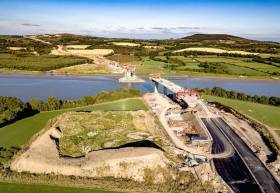Displaying items by tag: New Ross bypass bridge
Iconic Bridge: Vote Will See New Ross Bypass Bridge Named after Rose Kennedy
#InlandWaterways - The longest bridge in Ireland will finally be named in a fortnight's time after councillors in Piltown and New Ross voted by a small majority last week in favour of the Rose Fitzgerald Kennedy name at separate council meetings.
Both New Ross and Piltown Municipal District Councils met last week reports The NewRoss Standard as the long-running saga of what to call the new bridge (see previous coverage) took up considerable time at both meetings.
In New Ross, Cllr Michael Sheehan went against his colleagues and opted for the William Marshal Bridge, with the seven other councillors voting for the Rose Fitzgerald Kennedy Bridge.
Over in Piltown, five out of the six sitting councillors voted for the Pink Rock Bridge. However, the fact that a single councillor in Piltown voted in favour of Rose Fitzgerald Kennedy means that, as it stands, the vote is at 8-6 in favour of naming the 887m bridge after John F Kennedy's mother.
New Ross and Piltown councillors will meet together on October 3 at the Rhu Gleen Hotel in Slieverue, where the name will be voted on for a final time. If all 14 councillors from New Ross and Piltown vote as per last week, the iconic bridge will officially be named the Rose Fitzgerald Kennedy Bridge, ending a two-year saga over what to call the impressive structure.
For further reading on the new bridge (click here).
Afloat adds that the structure is located downriver of the Port of New Ross on the River Barrow, but sited before the disused Barrow Bridge which carried the Waterford City-Rosslare Harbour stretch of the Limerick railway line. This smaller section of the railway route line however closed in 2010.
The Barrow Bridge however remains in use albeit for the purposes of permitting shipping traffic to access New Ross. The bridge features a swing-bridge section that pivots to allow ships with up to 6,000 tonnes to transit the bridge and continue navigating upriver.
























































